15 stunning places on Earth that look like they're from another planet
Earth is full of weird and wonderful places. Here are some of the most alien landscapes our planet has to offer.
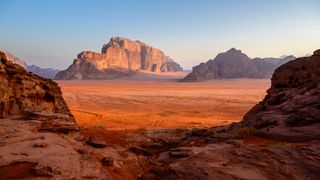
- 1. Grand Prismatic Spring, Yellowstone National Park
- 2. Wadi Rum, Jordan
- 3. Vatnajokull glacier, Iceland
- 4. Waitomo glowworm caves, New Zealand
- 5. Salar de Uyuni Salt Flats, Bolivia
- 6. Sossusvlei, Namib Desert
- 7. Lake Hillier, Australia
- 8. Lençóis Maranhenses National Park, Brazil
- 9. Danakil Depression, Ethiopia
- 10. Kilauea volcano, Hawaii
- 11. Pamukkale, Turkey
- 12. Rainbow Mountain, Peru
- 13. Kawah Ijen volcano, East Java, Indonesia
- 14. Han Son Doong, Vietnam
- 15. Fly Geyser, Nevada, U.S.
- Additional resources
For years, humans have fantasized about voyaging to distant worlds. Soon we will be traveling back to Earth's nearest neighbor with the upcoming crewed Artemis 2 mission around the moon — and NASA aims to use the Artemis program as a stepping stone toward Mars, where the agency wants to send astronauts in the late 2030s or early 2040s.
Luckily for most of us, Earth offers some truly awe-inspiring places to visit that will make you feel like you've just set foot on another planet. You don't need a spacecraft and millions of dollars to have an otherworldly experience, just your passport and a plane ticket.
From glaciers to deserts, volcanoes to caves, discover some of the most surreal places Earth has to offer.
Related: 10 Earth impact craters you must see
1. Grand Prismatic Spring, Yellowstone National Park
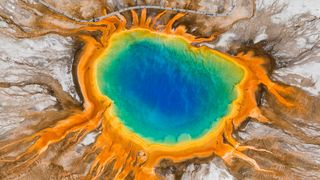
The Grand Prismatic Spring is the most photographed thermal feature in Yellowstone National Park, according to adventure publisher Outside.
According to the U.S. National Park Service, the ring of vivid colors measures 200 to 300 feet (60 to 90 meters) in diameter and 121 feet (36 m) deep — it's no wonder this striking spring is so popular with photographers and tourists alike.
The superheated spring is also a sought-after location for microscopic organisms known as thermophiles, which thrive in hot environments. ("Thermo" means heat, and "phile" means lover.) The hardiest of the thermophiles that live in the hottest water are colorless or yellow, whereas the orange, brown and green thermophiles live in the not-so-hot waters around the edge of the spring.
2. Wadi Rum, Jordan

Wadi Rum is a desert covering 277 square miles (717 square kilometers) located in South Jordan, according to the travel website WadiRum.jo. While exploring the dramatic wilderness, you'd be forgiven for thinking you've just set foot on Mars. With wide sandy valleys over a mile (1700 meters) high, smooth red dunes and mesmerizing rock formations, Wadi Rum is a wondrous place.
British liaison officer Thomas Edward Lawrence served with rebel forces during the Arab Revolt against the Ottoman Turks in the early 20th century. He described Wadi Rum as "vast, echoing, and God-like", according to the travel website Wadi Rum Nomads.
Lawrence wrote a book about the period called the "Seven Pillars of Wisdom," which was later made into the famous 1962 movie "Lawrence of Arabia." Several scenes from the movie were filmed in Wadi Rum, according to IMDB.
3. Vatnajokull glacier, Iceland
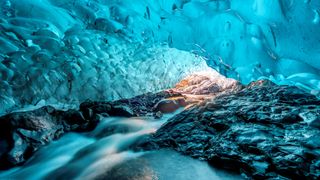
Vatnajokull glacier is the second-largest glacier in Europe. It covers 3,130 square miles (8,100 square kilometers) — 8% of Iceland's landmass — according to the travel website Guide to Iceland.
The monumental glacier is over 3,000 feet (900 m) deep in some places and conceals several active volcanoes below its surface, the most famous being Grímsvötn, Öræfajökull and Bárðarbunga. Geologists believe volcanic eruptions from this region are overdue and that we could therefore see significant activity within the next 50 years.
Vatnajökull is also home to enchanting ice caves like the one pictured above, with glacier and ice cave tours available during the winter months.
The glacier is shrinking year by year due to warming global temperatures; its thickness has decreased on average by about 3 feet (0.9 m) per year for the past 15 years.
4. Waitomo glowworm caves, New Zealand

If you fancy swapping a night under the stars for a different kind of light show, New Zealand's famous glowworm caves may be just the ticket.
According to NewZealand.com, the Waitomo Caves offer some of the best glowworm sights in the country. Take a trip through the Waitomo Caves either by boat, kayak or on foot and gaze up at the thousands of glowworms that call these caves home. The unique environment looks like something straight out of a sci-fi movie, with strange creatures illuminating the way like a star-studded sky.
Glowworms produce light via a chemical reaction, in a process known as bioluminescence, according to the Natural History Museum in London.
5. Salar de Uyuni Salt Flats, Bolivia
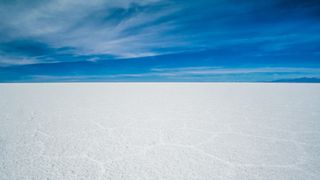
The Salar de Uyuni in Bolivia is the largest salt flat in the world, spanning over 3,800 square miles (10,000 sqaure km), according to the European Space Agency. The colossal salt flat is so large it can be seen from space.
The salt flat can reach depths of 32 feet (10 m) in its center. According to the travel website Salardeuyuni.com, Salar de Uyuni contains over 10 billion tons of salt. Interestingly, 70% of the world's lithium reserves are also found beneath the monumental salt flat.
These alluring salt flats in Bolivia's surreal Altiplano are a must-visit for those eager to experience something extraordinary.
6. Sossusvlei, Namib Desert
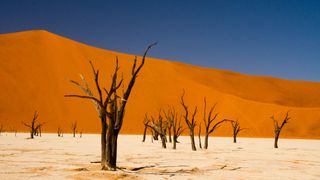
The towering red dunes in Sossusvlei are some of the tallest in the world, reaching nearly 1,300 feet (400 m), according to the travel website Sossusvlei. It's no surprise that they're one of the most visited attractions in Namibia.
The Martian-like environment is situated in the largest conservation area in Africa, the Namib-Naukluft National Park. The word Sossusvlei translates to "dead- end" and refers to the dunes preventing the Tsauchab River from flowing any further.
It has taken millions of years for the wind to sculpt these famous red dunes. The dune-forming dust comes from the Orange River — the longest river in South Africa. The dust flows into the Atlantic Ocean, where the Benguela current carries it northward. It then washes ashore, is carried by the wind and deposited inland.
7. Lake Hillier, Australia
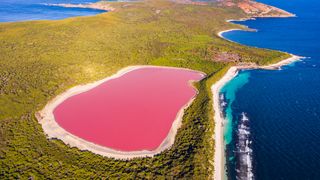
Lake Hillier, located on Middle Island, Western Australia, definitely looks like it belongs on another planet. The stark contrast between the pink lake, dark blue waters of the Indian Ocean and the luscious green forest are remarkable.
According to the travel website Hiller Lake, scientists are not 100% sure how the lake gets its rosy pink hue. The most likely suspect is the Dunaliella salina microalgae found in the lake, which produce carotenoids — a red pigment. But halophilic "salt-loving" bacteria in the salt crusts may also play a role. It has also been suggested that a reaction between the salt and sodium bicarbonate could be altering the color of the lake.
The mysterious salmon-pink lake is approximately 2000 feet (600 m) long and 820 ft (250 m) wide and is best viewed from the air.
8. Lençóis Maranhenses National Park, Brazil
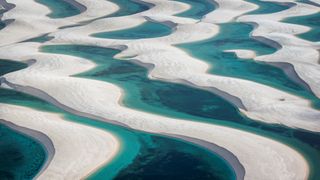
Lençois Maranhenses National Park contains vast swathes of white dunes sweeping across the otherworldly landscape. According to the travel website Lonely Planet, from May to September rainwater fills the crystal-clear pools, which are offset by striking white dunes.
The enchanting dunescape stretches over 43 miles (70 km) along the coast and over 30 miles (50 km) inland. Lençois translates as "bedsheets" in Portuguese and refers to the rolling white dunes that dominate the landscape.
The national park is best visited in June, July and August, when the lagoons are at their best, according to Lonely Planet.
9. Danakil Depression, Ethiopia
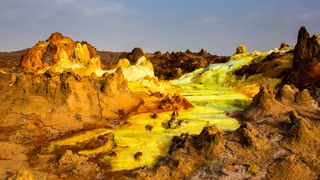
The Danakil Depression, Ethiopia, is one of the most inhospitable and alien places on Earth. Known as the "gateway to hell" according to the BBC, the Danakil Depression is probably the closest you'll ever be able to come to standing on the surface of Venus (without the crushing atmosphere, of course). Choking sulphuric acid and chlorine gases fill the air, while acid ponds and geysers pepper the landscape.
According to the BBC, temperatures in this region regularly reach 113 degrees Fahrenheit (45 degrees Celsius), making it one of the hottest places on Earth.
Related: What is the average temperature on Earth?
The Danakil Depression lies over 330 feet (100 m) below sea level in a rift valley. Rift valleys are formed when tectonic plates move apart at a "divergent plate boundary," according to The Geological Society. The underlying volcanic activity sculpts the landscape as Earth is pulled apart at the seams. Some of the Danakil Depression features can even be seen from space, according to NASA Earth Observatory.
10. Kilauea volcano, Hawaii

On the south coast of the Big Island of Hawaii, lava from the Kilauea volcano spews into the Pacific Ocean, creating striking scenes along the rugged coastline.
Kilauea is one of the most active volcanoes in the world, according to the travel website Go Hawaii. It is located in the Hawaii Volcanoes National Park, about 45 miles (72 km) southwest of the vibrant town of Hilo.
According to the volcano tourism website Volcano Discovery, Kilauea has been continually erupting since 1983. During that time, lava flows from the volcano have covered more than 38 square miles (100 square km) and destroyed almost 200 homes.
For the latest eruption updates, see the travel website Hawaii Guide and keep informed about the most recent lava news.
11. Pamukkale, Turkey
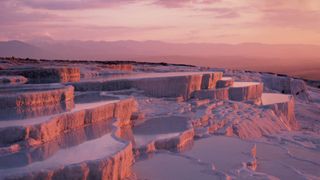
Pamukkale, known as the "Cotton Castle" of Turkey, is a serene landscape dotted with mineral pools surrounded by white "cotton-like" shelves and ridges.
The unique landscape was created when a spring with a high concentration of calcium bicarbonate spilled over the edge of a cliff and cascaded down the side. The water leaves behind the white calcium deposits we see today, according to the Republic of Turkey Ministry of Culture and Tourism.
Tourists from far and wide flock to Pamukkale to relax in the calm waters and the myriad spas that have sprung up across the region.
12. Rainbow Mountain, Peru
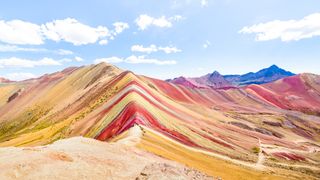
Rainbow Mountain is located in the Andes Mountains of Peru, about 17,000 feet (5,200 m) above sea level, according to the Rainbow Mountain tourism website. The streaked mountain is famed for its technicolor appearance, which is created by different mineral sediments.
Until recently, this rainbow jewel of the Andes was undiscovered, hidden beneath a blanket of snow. As the snow melted, the hidden gem was revealed, and the area now attracts hundreds of visitors every day.
Rainbow Mountain is also known as Vinicunca, according to the official tourism website Rainbow Mountain Peru. The word Vinicunca originates from Quechua — an indigenous language of Peru — and translates to "colored mountain".
13. Kawah Ijen volcano, East Java, Indonesia
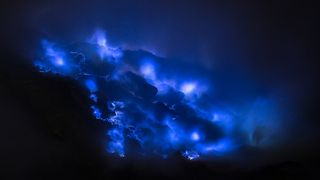
The electric-blue rivers ejected from Kawah Ijen volcano in eastern Java look like something from another world.
Contrary to what is commonly reported, the lava itself is not blue. The striking color is a result of volcanic sulfur emissions. According to Geology.com, the volcano emits sulfurous gases that ignite when they meet Earth's oxygen-rich atmosphere and burn with a rich blue flame. When the sulfurous gas condenses, it produces the infamous blue rivers that illuminate the volcanic landscape at night.
According to Smithsonian Magazine, the eerie blue glow is only visible at night because it's the flames that are blue rather than the lava itself. It looks like any other volcano during the daytime.
14. Han Son Doong, Vietnam

Deep in the heart of Phong Nha-Ke Bang National Park in Vietnam is Han Son Doong — the largest cave in the world. According to the Son Doong Cave tourism website, the average passage size for Han Son Doong is 220 feet (67 m). The cave is, on average, 656 feet (200 m) high and nearly 500 feet (150 m) wide.
In 2019, Han Son Doong's known size increased greatly when an underwater tunnel connecting the cave to another cave was discovered, according to an article published in Lonely Planet.
The otherworldy cave is large enough to house a block of New York City containing 40-story skyscrapers and is home to the world's largest stalagmites, which measure up to 260 ft (80 m), according to the Doong Cave tourism website.
15. Fly Geyser, Nevada, U.S.
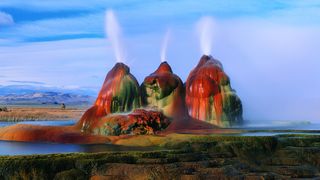
What do you get if you cross human error and geothermal pressure? A 12-ft-tall (3.5 meters) alien-looking structure.
Fly Geyser is a technicolor geyser situated on Fly Ranch in the middle of the Nevada desert. The structure spews out hot water, creating shallow pools home to hardy thermophilic algae that flourish in moist, hot environments, according to the tourism website Reno Tahoe.
The geyser was created by accident in 1964 when a geothermal energy company drilled the site in a bid to tap into the hot water below. But the water wasn't hot enough to be useful to the energy company, so the site was sealed up. According to Reno Tahoe, the well was improperly plugged and the scalding hot water pierced through the surface, creating the bizarre three-mound geyser we see today.
Additional resources
Explore Han Son Doong with this virtual tour from National Geographic. Learn more about the Danakil Depression and see what trips are available with the tourism website Brilliant Ethiopia. Discover why sulfuric gases can produce the infamous blue flames at Kawah Ijen volcano with this article from Interesting Engineering.
Bibliography
National Park Service. Grand Prismatic Spring
Guide to Iceland, Vatnajökull Travel Guide
New Zealand tourist website, glowworm caves
Sossusvlei, Welcome to the land that time forgot
Hiller Lake, the pink lake of Australia
Lonely Planet Parque Nacional dos Lençóis Maranhenses
The Geological Society, Plate Tectonic Stories, East African Rift Valley, East Africa
NASA Earth Observatory, Curiosities of the Danakil Depression
The Hawaiian Islands, Hawaii Volcanoes National Park
Republic of Turkey Ministry of Culture and Tourism, Pamukkale
Rainbow Mountain Peru, official information website.
Geology.com, Kawah Ijen Volcano. Blue flames and the largest highly acidic lake in the world.
Follow us on Twitter @Spacedotcom or on Facebook.
Join our Space Forums to keep talking space on the latest missions, night sky and more! And if you have a news tip, correction or comment, let us know at: community@space.com.
Get the Space.com Newsletter
Breaking space news, the latest updates on rocket launches, skywatching events and more!

Daisy Dobrijevic joined Space.com in February 2022 having previously worked for our sister publication All About Space magazine as a staff writer. Before joining us, Daisy completed an editorial internship with the BBC Sky at Night Magazine and worked at the National Space Centre in Leicester, U.K., where she enjoyed communicating space science to the public. In 2021, Daisy completed a PhD in plant physiology and also holds a Master's in Environmental Science, she is currently based in Nottingham, U.K. Daisy is passionate about all things space, with a penchant for solar activity and space weather. She has a strong interest in astrotourism and loves nothing more than a good northern lights chase!
